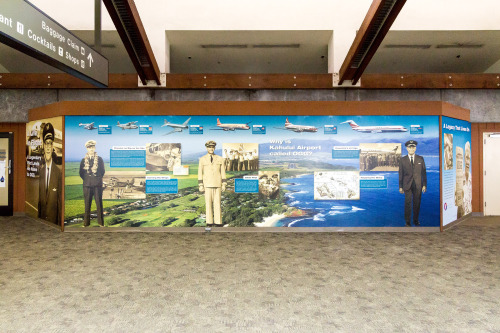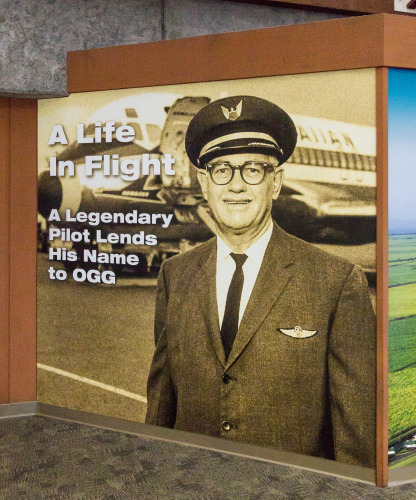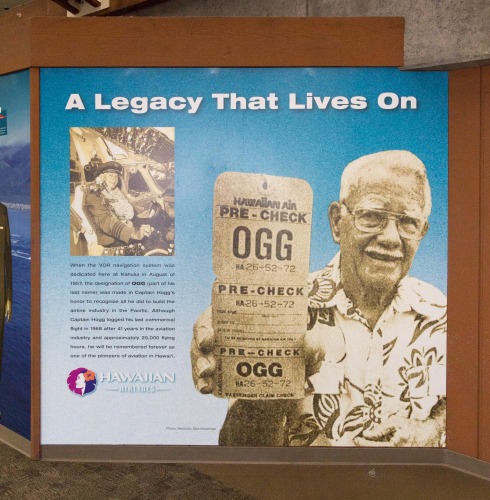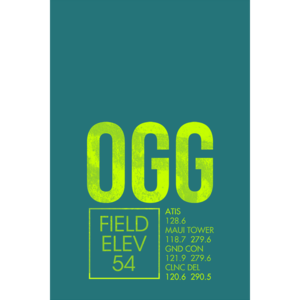For most travelers to Maui, the airport code for Kahului Airport – OGG – has been a mystery, if they’ve thought about it at all.
Now there’s an 8-foot tall, 42-foot wide information-packed wall at the airport that tells the story behind the three letter code. And it turns out the airport is named for Capt. Jimmy Hogg, a Hawaiian Airlines pilot,Kaua‘i native and aviation pioneer whose life and flying career is charmingly described in the video below.
The new history wall is at Gate 19 at Maui’s Kahului Airport and was presented by Hawaiian Airlines, the State Department of Transportation (DOT) and the Transportation Security Administration.
(All photos courtesy Hawaiian Airlines, except for the OGG image, which is courtesy of O8 Left, a really cool line of aviation and airport-related art.
Thanks for visiting Stuck at the Airport. Subscribe to get daily travel tidbits. And follow me on Twitter at @hbaskas and Instagram.




I was recently walking through the Maui Airport when I discovered an excellent display telling about Captain Bertram “Jimmy” Hogg, an aviation pioneer and an important figure in Hawaiian Airlines’ history. Unfortunately, the claim that Maui’s three letter identifier OGG was a tribute to Capt Hogg is simply not true.
In the early days of aviation, airports and navigation aids were simply named after the city or county they served. Additional facilities in the same area had names added by the locals to distinguish one facility from the others. In those days, messages were sent by telegraph, and to this day radio navigation aids still broadcast their identifiers in Morse code. For brevity, the facilities’ name was abbreviated to three unique letters that could be easily transmitted and understood as an identifier. Using that convention, Denver’s primary airport, Stapleton International, and today’s Denver International Airport were both tagged DEN. Nearby, Broomfield’s Jefferson County Airport became BJC, and the Army’s Buckley Field became BKF.
When the Maui VOR was commissioned in 1947, Americans were still honoring their heroes from World War II, which had ended only two years earlier. Yet even as Chicago honored its own Medal of Honor winner, Butch O’Hare, the airport retained its Orchard Field identifier ORD. So why wasn’t Maui’s identifier derived from Kahalui, or Maui? In 1947, Hawaii wasn’t a state, there was less regulation and oversight from the American Civil Aviation Authority, and there was more opportunity to break from the conventions used to identify aviation facilities. OGG was chosen as the three letter identifier for the Maui VOR to honor a Pan Am Captain who had successfully ditched a Boeing Stratocruiser less than a year earlier, halfway between Honolulu and San Francisco, Captain Richard Ogg.
Pan Am Flight 6 had an engine failure and a runaway propeller in the middle of the night, making it unable to continue its journey to San Francisco or return to Hawaii. Capt OGG used radio navigation to find his way to the Coast Guard Cutter Pontchartrain, located at a one square mile patch of ocean called Ocean Station November. The plane then circled until daybreak before ditching behind the ship. Everyone aboard the Pan Am Flight 6 survived the ditching, which was filmed and photographed from the back of the Pontchartrain. The film was shown in movie theater film reels around the world, as well as a movie to promote the U.S. Coast Guard. The dramatic pictures were featured on the October 28, 1946 cover of Life Magazine, and the story was inspiration for the Hollywood movie “Planecrash.” Capt Richard Ogg became an overnight hero who name was even more recognized than Chelsea “Sully” Sullenberger is today.
So who was decided to break with convention and honor Capt Ogg, by using his name as the identifier for the Maui VOR? The best hint is on the display in the Maui terminal, under the heading “Mapping the Airways.” A local aviator from Lihue, one of the few instrument rated pilots in Hawaii, a pioneer at Interisland Airlines, and the pilot responsible for setting up and checking Hawaii’s new radio navigation system, Captain Bertram “Jimmy” Hogg. If anybody had actually asked Capt Hogg which letters to use when putting his name on the Maui VOR, the obvious choice would have been to drop the G, if for no other reason, to avoid being confused with Dick Ogg. But nobody had to ask; Jimmy Hogg simply submitted the paperwork, and Ogg’s name has been attached to Maui ever since.
I am sure that Hawaiian Airlines is more than proud to honor one of its own aviation pioneers, with a very fine display, for the thousands of travelers who pass through the Maui airport. This comment is in no way intended to discredit Capt Hogg, or his importance to Interisland Airlines, Hawaiian Airlines, or Hawaii’s aviation history. Not only was Captain Hogg an important figure in Hawaii’s aviation history, he is arguably aviation’s most successful tagger. For nearly seventy years, the Maui VOR has been broadcasting the last three letters of his name in Morse code.
For the record, I don’t see anything malicious in Capt Hogg’s choice of letters to identify Maui. In 1947, nobody would have questioned what those letters represented. As the story of Pan Am flight 6 and Richard Ogg faded from Hawaii’s collective memory, however, I’m sure that Capt Hogg got a chuckle when fellow aviators saw OGG on schedules, flight papers, and baggage tags, or heard the perpetual broadcast from Maui’s VOR and began to ask, “Is that you?”
As I looked at that fine tribute to Capt Hogg, however, I couldn’t help but feel that it was a real disservice to allow the true story of a real aviation hero to simply be dismissed. Maui’s three letter identifier did break with convention, and it was accepted as Maui’s three letter identifier because it honored one of the great heroes in aviation history, Capt Richard OGG.